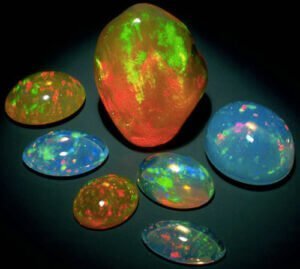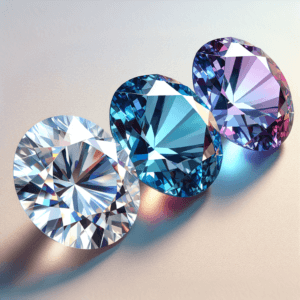What Are The Three Hardest Gemstones?
What Are The Three Hardest Gemstones? Inviting you on an exhilarating journey exploring precious gems, this article spotlights the three hardest gemstones in the world. In this exploration, you’re going to not only identify these remarkably tough gems but also understand what makes them incredibly durable. A captivating tour invites you to visualize the unseen world of sturdiness and sparkle, providing a new perspective on the Earth’s hidden treasures. Buckle up your curiosity, as we prepare to embark on this striking exploration.

Defining Gemstone Hardness
Gemstone hardness is a measure of a gem’s resistance to scratches or abrasions. It’s an essential quality you should keep in mind when buying any type of jewelry, as it can indicate how durable the jewel will be over time.
Understanding Mohs Scale of Hardness
The Mohs scale of hardness is an arbitrary unit used to quantify the hardness of minerals and gemstones. The scale was proposed by German mineralogist Friedrich Mohs in 1812, and it ranges from 1 (being the softest) to 10 (the hardest), based on the ability of a harder material to scratch a softer material.
Correlation of Hardness and Durability
While hardness is just a measure of how resistant a gemstone is to scratches, it also has a direct correlation with durability. Generally, the harder a gemstone is, the more resilient it is to damages that may result from daily wear and tear. It’s especially crucial when considering gemstones for everyday jewelry, like engagement rings.
How Hardness is Measured
Hardness in gemstones is measured using the Mohs scale of mineral hardness. The scale assigns hardness values based on which minerals can scratch others, with diamond being the hardest mineral known to man, ranking at a 10.
Overview of Diamond
Diamonds, known for their brilliance and resilience, are among the world’s most revered stones.
Historical and Cultural Importance of Diamond
Diamonds have long held importance in various historical and cultural contexts around the world. They have symbolized wealth and power, and have even been thought to provide protection and healing powers, particularly in Indian culture.
Geological Formation of Diamonds
Diamonds form deep within the Earth’s crust under extreme heat and pressure conditions, and they are brought to the surface through volcanic eruptions. Since these conditions are difficult to recreate, natural diamonds are incredibly rare and precious.
Why Diamonds Rank Highest on Mohs Scale
Diamonds score a perfect 10 on the Mohs scale, as they are the hardest known substance in existence. They are four times harder than the next hardest mineral, corundum, from which rubies and sapphires are formed.

Properties of Diamond
Diamonds are not only prized for their hardness but also their physical attributes.
Physical Attributes of Diamond
Known for their stunning brilliance and fire, or light return, diamonds have an exceptional luster. They are also highly transparent and possess a high refractive index, contributing to their brilliance.
Varieties of Color
While diamonds are commonly associated with a clear, white color, they can also come in a range of hues, including yellow, blue, and even black. The diverse range of colors is caused by impurities within the diamond’s structure.
Sourcing Sites for Diamonds
Diamonds are found across the globe, with significant deposits in countries like Russia, Botswana, Canada, and Australia, among others.
Overview of Corundum
Next to diamonds, corundum is the second hardest mineral, known as the jewels ruby and sapphire.
Historical and Cultural Significance of Corundum
Rubies and sapphires, both corundum’s varieties, hold a special place in many cultures. Rubies symbolize love and power, while sapphires represent wisdom and loyalty, and have been adored for centuries.
Geological Formation of Corundum
Corundum forms under high pressure and temperature conditions, usually in metamorphic rocks. It crystallizes in the hexagonal system and is most commonly found in large, prismatic crystals.
Corundum in the Mohs Hardness Scale
On the Mohs hardness scale, corundum holds solid at a 9, making it the second hardest gemstone after diamonds.

Properties of Corundum
Corundum is a colorful gemstone known for its varieties.
Physical Attributes of Corundum
Corundum displays vibrant colors when it is cut and polished. It has good transparency and can have a vitreous to adamantine luster. It also exhibits a phenomenon known as asterism or the star effect.
Corundum Varieties: Ruby and Sapphire
Corundum appears in various colors, each known by different names. The red variety is known as Ruby, while all other colors are called Sapphires.
Sourcing Sites for Corundum
Noteworthy sources for corundum include Myanmar for rubies and Kashmir and Sri Lanka for sapphires.
Overview of Chrysoberyl
Chrysoberyl, ranking just below corundum on the hardness scale, is a fascinating gem largely unheralded compared to diamond and corundum.
Historical and Cultural Significance of Chrysoberyl
While not as universally recognized as diamonds or corundum, chrysoberyl finds its roots in history, with cat’s eye talismans believed to protect against the evil eye.
Geological Formation of Chrysoberyl
Chrysoberyl forms in granitic rocks and pegmatites. It crystallizes in the orthorhombic system and is commonly found in short prismatic crystals.
Chrysoberyl in the Mohs Hardness Scale
Chrysoberyl ranks an 8.5 on the Mohs hardness scale, making it a sturdy gemstone.

Properties of Chrysoberyl
Chrysoberyl exhibits distinct physical characteristics that distinguish it from other gemstones.
Physical Characteristics of Chrysoberyl
Chrysoberyl can range from yellow to green to brown in color. It exhibits good transparency and has a vitreous luster. Like corundum, chrysoberyl also exhibits a star effect or chatoyancy under certain light conditions.
Rare Varieties: Alexandrite and Cat’s Eye Chrysoberyl
The rare and highly valued varieties include alexandrite, which changes color from green in daylight to red under incandescent light, and cat’s eye chrysoberyl, which displays a cat’s eye effect under light.
Sourcing Sites for Chrysoberyl
The primary source for chrysoberyl is Brazil; other significant sources include Myanmar and Sri Lanka.
Comparison of the Three Hardest Gemstones
Each of these three gemstones—diamond, corundum, and chrysoberyl—has unique qualities, but all are revered for their hardness and durability.
Comparing Diamond, Corundum, and Chrysoberyl
Diamond, with a Mohs hardness of 10, is the hardest and most resilient of all, perfect for everyday wear. Corundum, ranking at 9, offers significant hardness with vibrant colors through ruby and sapphire, while Chrysoberyl, at a hardness of 8.5, possesses unique optical phenomena and color-changing abilities.
Hardest Gemstones in Jewelry Application
These three gemstones have high utility in jewelry, especially in pieces designed for regular wear like rings and bracelets. Diamonds are commonly used in engagement rings, while sapphire, ruby, and cat’s eye are popular in various jewelry forms for their color and special effects.
Durability and Wear of Hard Gemstones
A gemstone’s hardness directly links to its durability and wearability. Hard gemstones like diamonds, corundum, and chrysoberyl resist abrasions and scratches that softer gems might easily accumulate, making them last for generations.

Application of Hard Gemstones
Beyond their beauty, these hard gemstones also serve various purposes in industries and culture.
Gemstones in Luxury Jewelry
Hard gemstones often form the centerpiece of luxury jewelry pieces, coveted for their sparkle, color, and durability.
Industrial Application of Hard Gemstones
Apart from jewelry, these gemstones—particularly diamond—have crucial industrial applications. Diamond’s hardness makes it ideal for cutting, grinding, drilling, and engraving.
Symbolism and Cultural Meaning
Throughout cultures and histories, these gemstones have been attributed with various symbolic meanings and cultural associations, like love, wisdom, and protection.
Caring for Hard Gemstones
Even though these gemstones are incredibly hard, they still require specific care to keep them in the best condition possible.
Cleaning and Maintenance of Hard Gemstones
Regular cleaning using a soft brush, warm water, and mild soap can help keep these gemstones gleaming. It’s best to avoid strong detergents and temperature changes that might damage the stone.
Storage and Handling Tips
Store each piece separately to avoid any potential scratches due to friction. Avoid wearing these stones during any heavy physical activity to keep them safe from impacts.
Professional Servicing for Gemstones
Professional servicing for periodic deep-cleaning, inspection for wear and tear, and necessary repair work can ensure your treasured gemstones’ longevity.
In conclusion, diamonds, corundum, and chrysoberyl are the three hardest gemstones known to us. Each gemstone unique in its formation, physical properties, and historical significance, and they hold great value in the world of fine jewelry and beyond.



